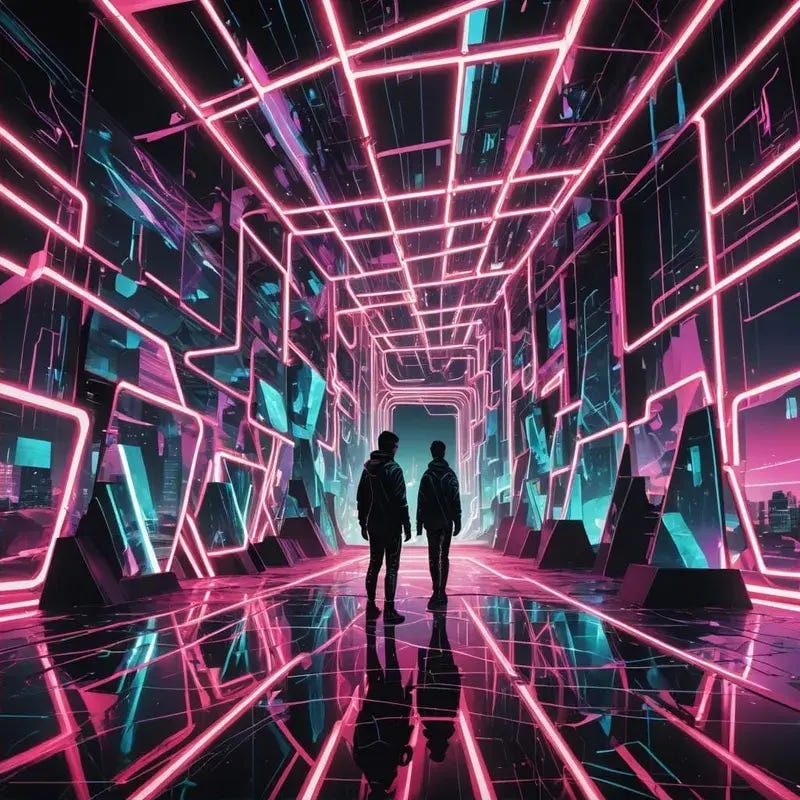What does it mean to be present? In our increasingly digitized world, the concept of embodiment is undergoing a transformation. This essay explores how digital technologies mediate bodily experiences and influence our sense of authenticity, drawing upon key thinkers in the field while considering the implications for trust in online interactions.
The landscape of digital embodiment encompasses a range of technologies that reshape our physical and perceptual experiences. Virtual Reality (VR) immerses users in fully realized digital environments, while Augmented Reality (AR) overlays digital information onto the physical world. Social media avatars and gaming personas extend our presence into digital realms, while haptic technologies and emerging brain-computer interfaces blur the boundaries between our physical bodies and digital spaces.
Katherine Hayles' concept of posthumanism provides a helpful framework for understanding digital embodiment. Hayles1 argues that information technologies are reconfiguring our understanding of subjectivity, challenging traditional notions of the body as a fixed, biological entity. In this posthuman view, cognition extends beyond the brain, encompassing technological interfaces that augment our sensory and cognitive capacities. This perspective suggests that digital embodiment may offer new avenues for authentic self-expression, expanding the possibilities of how we present ourselves and interact with others.
Authenticity in virtual spaces is always contextual and mediated.
Don Ihde's postphenomenology offers a nuanced counterpoint to Hayles' expansive view. Ihde2 emphasizes the mediating role of technology in human experience, distinguishing between embodiment relations (where technology becomes an extension of the body) and hermeneutic relations (where technology represents reality). This framework highlights both the potential and limitations of digital embodiment, reminding us that authenticity in virtual spaces is always contextual and mediated.
The intersection of digital embodiment and trust in online interactions presents unique challenges and opportunities. Sherry Turkle's work on online identity provides valuable insights into this dynamic. Turkle3 observes that digital avatars can serve as vehicles for exploring different facets of identity, potentially fostering a sense of authenticity through experimentation. However, she also warns of the "disinhibition effect," where the perceived anonymity of digital spaces can lead to behaviors disconnected from one's offline identity.
The challenge lies in leveraging the expansive possibilities of digital embodiment while maintaining a grounded sense of self and fostering genuine trust.
Synthesizing these perspectives reveals a complex relationship between digital embodiment, authenticity, and trust. While technologies like VR and AR offer immersive experiences that can enhance empathy and connection, the mediated nature of these interactions may also create barriers to establishing deep, authentic relationships. The challenge lies in leveraging the expansive possibilities of digital embodiment while maintaining a grounded sense of self and fostering genuine trust.
The concept of digital mindfulness emerges as a crucial consideration for future exploration. Mindful engagement with digital embodiment technologies may help us maintain authenticity and build trust in online interactions, encouraging us to be present and intentional in our digital experiences.
The continuing evolution of digital embodiment technologies will persistently challenge our understanding of presence, identity, and authenticity. Leveraging a critical and yet open-minded approach, there is an opportunity to harness the potential of digital embodiment to expand our capacities for connection and self-expression while preserving the essence of authentic human interaction in the modern world.
My Personal Reflections
Hayles, N. K. (1999). How we became posthuman: Virtual bodies in cybernetics, literature, and informatics. The University of Chicago Press.
Ihde, D. (1990). Technology and the lifeworld: From garden to earth. Indiana University Press.
Turkle, S. (2011). Alone together: Why we expect more from technology and less from each other. Basic Books.


